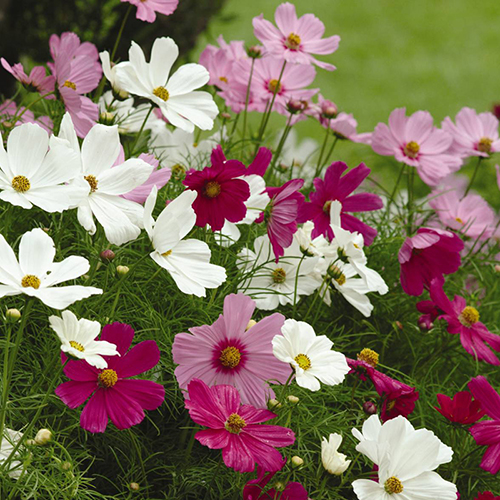COSMOS FLOWER

About Cosmos Flowers
If you have anything but a green thumb, can’t grow a weed to save your soul and are hopeless when it comes to differentiating a weed from an annual but you love flowers, have I got a flower for you! Old-time cosmos flowers are amongst the easiest blooms to grow and can grow almost anywhere. Piqued your curiosity? Keep reading for more cosmos flower info and history.
Cosmos Flower History
Referring to cosmos as “old-time” flowers is apropos. Native to Mexico, cosmos plants were brought back to Madrid in great abundance by 16th Century Spanish explorers. The wife of the English ambassador to Spain collected cosmos seeds and returned to England with them in the late 1700’s. Fifty years later, cosmos made its way over the pond and into the gardens of the United States.
Spanish priests cultivated cosmos plants in their mission gardens and were so taken with the evenly placed petals they christened the flower “Cosmos,” the Greek word for ‘ordered universe of harmony.’ In the chaos of modern life, you too can have a little harmony and order in the garden by planting cosmos plants.
Additional Cosmos Flower Info
Cosmos is a member of the Aster family and, like asters, have a daisy-like flower. They are prodigious bloomers and ridiculously easy to grow from seed in almost any type of soil. While germinating, cosmos needs water, but once the plants are established, they are drought tolerant. They will self-sow and take kindly to being whacked back by blooming yet again. All in all a foolproof flower if ever there was one
Cosmos belongs to the family of Compositae, wherein there are 20 species. Out of those 20, really only two are familiar to most gardeners: Cosmos sulphureus and Cosmos bipinnatus. I’ve been growing C. bipinnatus for eons, probably because my grandmother grew them. This variety has fern-like wispy foliage and blossoms that range from white through the spectrum of pink to dark rose in hue.
Growing Cosmos Plants in Gardens
You can buy cosmos from the nursery or sow your own seed, which really is simple and less expensive. Either sow seeds directly into the garden after all danger of frost has passed or start them indoors 4-5 weeks before the last spring frost date. Choose a sunny site with well-draining soil of average to poor fertility and neutral to slightly alkaline pH. Space cosmos plants two feet apart or, for tall cosmos, place them closer together so the plants can support each other.
Oh, I forgot to mention tall cosmos. Some varieties of cosmos can get tall, really tall. When I was researching this, most sources said 5 feet, but I am here to tell you that we have a stand of cosmos that is as tall as the eave of our house! The house is only a single story but is still about 7 feet or more. They are amazing!
Now that you have planted your cosmos, what kind of care do they need? Not much. Really, problems arise if you care for them too much. It’s best to ignore them. Don’t feed them, don’t amend the soil or side-dress, don’t water them once they have established unless it’s so dry that they wilt. Ignore them.
Growing cosmos is probably the one time in gardening where not paying attention to the care of the plant will work in your favor. And, you get such a reward! Prolific blossoms for an extended period of time that make great cut flowers, dried flowers, companion plants and as an added bonus attract butterflies! Actually, our large stands of cosmos attract more than butterflies. Our resident Anna hummingbirds can’t seem to get enough of them!
So, gardening challenged, go ahead. Rake up some dirt lightly, dump some seeds in and water. Then sit back, literally, and prepare to be amazed at what an amazing gardener you are.
Question & Answers
Don't get what you are looking for? Ask Question